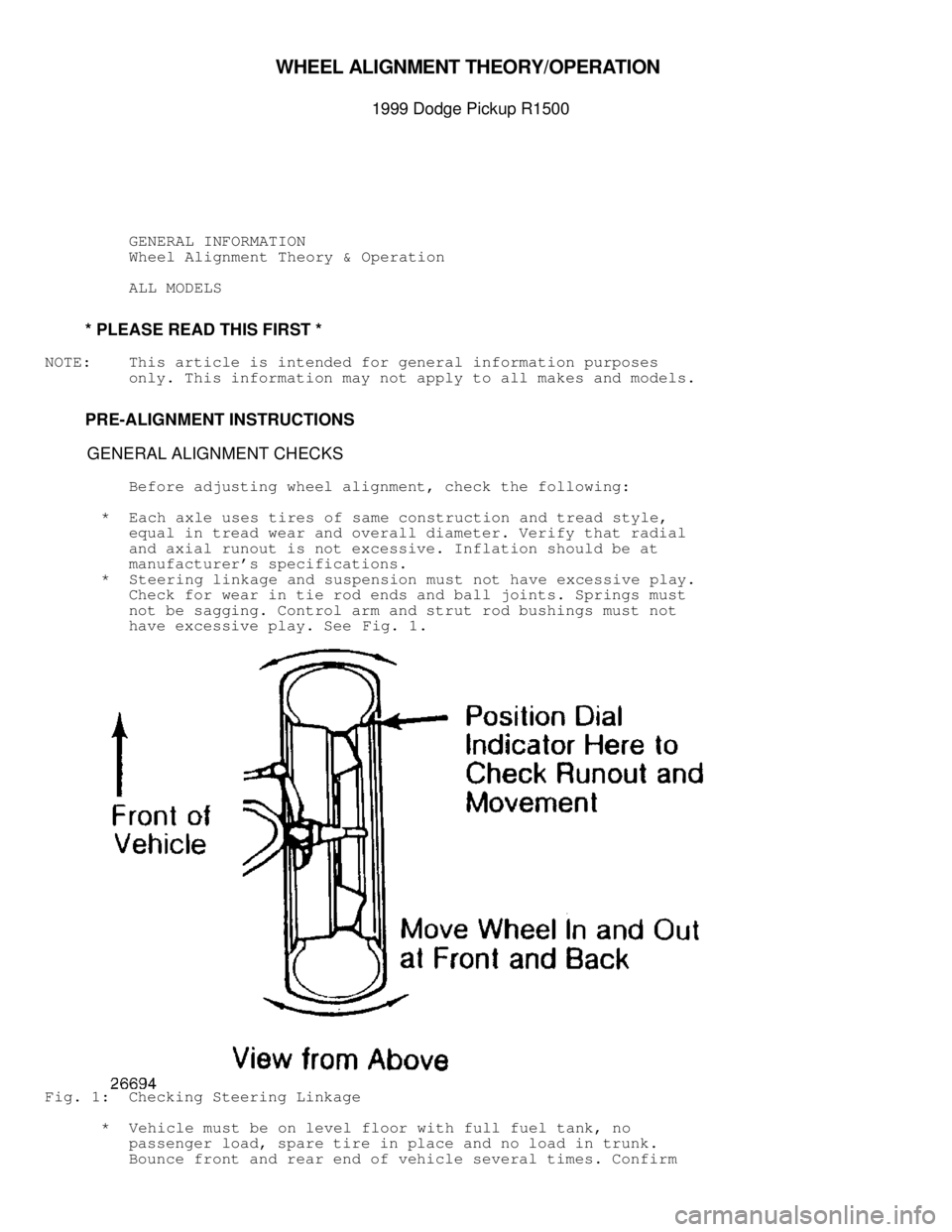Page 1582 of 1691

Caravan, Dakota, Durango, Town & Country, & Voyager ...... 55 (75)\
Wheel Lug Nuts
Caravan, Town & Country, & Voyager ..................... 100 (135)\
Dakota & Durango
1998 ........................................... 85-110 (115-149)\
1999 ........................................... 85-115 (115-156)\
Ram Pickup
5 Stud Wheel ........................................... 95 (129)\
8 Stud Wheel .......................................... 135 (183)\
8 Stud Dual Wheel ..................................... 145 (197)\
Ram/Van Wagon
5 Stud ......................................... 80-110 (108-149)\
8 Stud ........................................ 120-150 (163-203)\
(1) - Tighten an additional 1/4 turn.
( 2) - Information is not available.
������������������\
������������������\
������������������\
������������������\
������������������\
������������������\
������������������\
�������������
ALIGNMENT SPECIFICATIONS
WHEEL ALIGNMENT SPECIFICATIONS������������������\
������������������\
������������������\
������������������\
������������������\
������������������\
������������������\
�������������
Application Preferred Range
Caravan, Town & Country,
& Voyager
1998 2WD & AWD With
14" & 15" Tires ( 1)
Camber ( 2)
Front .................. 0.15 ................. -0.25 To 0.55
Rear .................... 0 ................... -0.25 To 0.25
Caster ( 2) ............... 1.4 ..................... 0.4 To 2.4
Toe-In ( 3)
Front ............... 0.05 (1.5) .. -0.05 To 0.15 (-1.5 To 4\
)
Rear ................... 0 (0) ........ -0.2 To 0.2 (-5 To 5\
)
Toe-In ( 2)
Front ................... 0.1 ................... -0.1 To 0.3
Rear ..................... 0 .................... -0.4 To 0.4
1998 2WD & AWD With 15",
16" Or 17" Tires ( 4)
Camber ( 2)
Front ( 1) ............. 0.05 ................. -0.35 To 0.45
Rear ................... 0 ................... -0.25 To 0.25
Caster ( 2) ............... 1.4 ..................... 0.4 To 2.4
Toe-In ( 3)
Front ............... 0.05 (1.5) .. -0.05 To 0.15 (-1.5 To 4\
)
Rear ................... 0 (0) ........ -0.2 To 0.2 (-5 To 5\
)
Toe-In ( 2)
Front .................. 0.1 .................... -0.1 To 0.3
Rear .................... 0 ..................... -0.4 To 0.4
Dakota
Camber ( 2)
All Models ............... 0.38 ................. -0.12 To 0.88
Caster ( 2)
2WD shortbed ............. 2.99 .................. 2.49 To 3.49
4WD Shortbed ............. 3.16 .................. 2.66 To 3.66
2WD Longbed .............. 3.09 .................. 2.59 To 3.59
4WD Longbed .............. 3.23 .................. 2.73 To 3.73
2WD Club Cab ............. 3.13 .................. 2.63 To 3.63
4WD Club Cab ............. 3.27 .................. 2.77 To 3.77
Toe-In ( 3)
All Models ............ 0.07 (1.5) .... 0.02 To 0.12 (0.5 To 3\
)
Page 1584 of 1691

4WD Short Bed .......... 3.15 ................... 2.5 To 4.15
2WD Long Bed ........... 3.65 .................. 2.65 To 4.65
4WD Long Bed ........... 3.25 .................. 2.25 To 4.25
Ram 3500
2WD Long Bed ........... 3.25 .................. 2.25 To 4.25
4WD Long Bed ........... 2.9 ..................... 1.9 To 3.9
2WD Quad Cab Long Bed .. 3.45 .................. 2.45 To 4.45
4WD Quad Cab Long Bed ... 3 .......................... 2 To 4
Toe-In (3)
All Models ............ 0.05 (1.5) ...... 0 To 0.1 (0 To 2.5\
)
Toe-In ( 2)
All Models ................ 0.1 ...................... 0 To 0.2
Ram Van/Wagon
Camber ( 2) .................. 0 .................... -0.6 To 0.6
Caster ( 2) ................. 2.5 .................... 1.5 To 3.5
Toe-In ( 3) ................ 0 (0) ...... -0.12 To 0.12 (-3 To 3)
Toe-In ( 2) .................. 0 ................... -.25 To 0.25
( 1) - Specification is for P205/75R14 & P215/65R15 tires.
( 2) - Measurement in degrees.
( 3) - Measurement in inches (mm).
( 4) - Specification is for P205/75R15, P215/65R16 or P215/60R 17
tires.
( 5) - Camber not set on 4WD models.
( 6) - 1999 models 3.85 preferred, 2.85 To 4.85 range.
������������������\
������������������\
������������������\
������������������\
������������������\
������������������\
������������������\
�������������
Page 1585 of 1691

�
WHEEL A LIG NM EN T T H EO RY/O PER ATIO N
�
1999 D odge P ic ku p R 1500
GENERAL INFORMATION
Wheel Alignment Theory & Operation
ALL MODELS
* PLEASE READ THIS FIRST *
NOTE: This article is intended for general information purposes
only. This information may not apply to all makes and models.
PRE-ALIGNMENT INSTRUCTIONS
GENERAL ALIGNMENT CHECKS
Before adjusting wheel alignment, check the following:
* Each axle uses tires of same construction and tread style,
equal in tread wear and overall diameter. Verify that radial
and axial runout is not excessive. Inflation should be at
manufacturer's specifications.
* Steering linkage and suspension must not have excessive play.
Check for wear in tie rod ends and ball joints. Springs must
not be sagging. Control arm and strut rod bushings must not
have excessive play. See Fig. 1.
Fig. 1: Checking Steering Linkage
* Vehicle must be on level floor with full fuel tank, no
passenger load, spare tire in place and no load in trunk.
Bounce front and rear end of vehicle several times. Confirm
Page 1587 of 1691
Fig. 3: Determining Camber Angle
CASTER
1) Caster is tilting of front steering axis either forward or
backward from vertical, as viewed from side of vehicle. See Fig. 4.
2) When axis is tilted backward from vertical, caster is
positive. This creates a trailing action on front wheels. When axis is
tilted forward, caster is negative, causing a leading action on front
wheels.
Fig. 4: Determining Caster Angle
TOE-IN ADJUSTMENT
Toe-in is the width measured at the rear of the tires
Page 1588 of 1691

subtracted by the width measured at the front of the tires at about
spindle height. A positive figure would indicate toe-in and a negative
figure would indicate toe-out. If the distance between the front and
rear of the tires is the same, toe measurement would be zero. To
adjust:
1) Measure toe-in with front wheels in straight ahead
position and steering wheel centered. To adjust toe-in, loosen clamps
and turn adjusting sleeve or adjustable end on right and left tie
rods. See Figs. 2 and 5.
2) Turn equally and in opposite directions to maintain
steering wheel in centered position. Face of tie rod end must be
parallel with machined surface of steering rod end to prevent binding.
3) When tightening clamps, make certain that clamp bolts are
positioned so there will be no interference with other parts
throughout the entire travel of linkage.
Fig. 5: Wheel Toe-In (Dimension A Less Dimension B)
TOE-OUT ON TURNS
1) Toe-out on turns (turning radius) is a check for bent or
damaged parts, and not a service adjustment. With caster, camber, and
toe-in properly adjusted, check toe-out with weight of vehicle on
wheels.
2) Use a full floating turntable under each wheel, repeating
test with each wheel positioned for right and left turns. Incorrect
toe-out generally indicates a bent steering arm. Replace arm, if
necessary, and recheck wheel alignment.